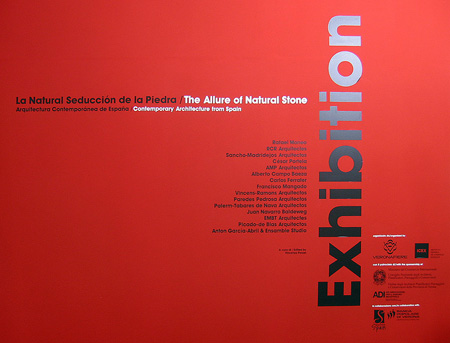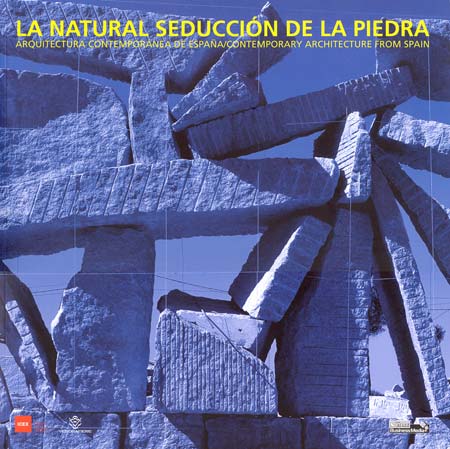10 Novembre 2007
English
La natural seduccion de la pietra – The Allure of Natural Stone
Il Sole24Ore BusinessMedia
Faenza Industrie Grafiche, Faenza, Ravenna, 2007
160 pages, Spanish/English, euro 30.00

Snapshot of the show set-up at Marmomacc 2007
The natural aptitude of stone materials in responding to the needs of designers, clients and users of architectural spaces has come to the fore during recent international events at Marmomacc in Verona; this year, particular attention focused on such realities in Spain. La natural seducciòn de la piedra – an exhibition boasting a wealth of graphic material and ‘live’ samples of exemplary projects in Spain – was organised and coordinated by Vincenzo Pavan; it presented an impressive selection of contemporary architecture to exemplify how the world of quarrying and production achieves preferential technical excellence in the constructive processes and approaches that accompany the creative excellence of designers themselves. There is absolutely no doubt – even by glancing through the catalogue or admiring the exhibition panels during the 42nd Marmomacc in Verona – that research work such as the project by Antòn Garcìa-Abrìl and Ensamble Studio for the Galicia Higher School of Music Studies (that took an award at Marmomacc 2005) – is a vital and successful occasion for renewal of conventional building applications that now come to the fore in the Theatre and Auditorium of San Lorenzo de El Escorial designed by Picado-De Blas Arquitectos, the Rectorate of the Vigo University Campus by EMBT Arquitectes or the Casa en Las Encinas near Madrid by Vicens-Ramos Arquitectos. The official presentation of the exhibition last 6 October in the Boggian Hall of Castelvecchio saw Antòn Garcìa Abrìl outline his new project (already premiered through Architetturadipietra.it in its initial project and construction stages). This new work, in fact, is highlighted on the cover of the exhibition catalogue published by IlSole24Ore BusinessMedia and is described in the closing pages.
The catalogue – just like the exhibition – accurately presents texts, original technical drawings and photographic details covering fifteen works – involving both acknowledged “masters” and young architects making their names for quality and consistency in their applications. The catalogue opens with two short essays by Luis Fernàndez-Galiano and Ignacio Fernàndez Solla – important interpretative analysis of the works themselves and the historic-cultural context expressed in contemporary Spanish architecture. The first essay focuses on stone as the ideal construction material in modern and contemporary architecture and then analyses a topic of major current interest – the dualism between applications in solid stone and applications in thin cladding in Spanish and international spheres. The second essay, first and foremost, defines the stages in natural stone applications involving ventilated facade anchorages alongside a continual process of evolution whereby slabs become so thin as to achieve the translucency of alabaster in the applications designed by Josep Lluis Mateo; the essay then completes this national overview by identifying Rafael Moneo as an exceptional figure: in short, he exploits every different and possible application of natural stone with immense skill; specific technologies are freely utilised to reflect the conceptual input characterising the overall nature of every project.
Other views of the show set-up at Marmomacc 2007
This chronology of designers and the continuity of design content could only begin with the figure of Rafael Moneo: not only for the undisputed status of the theoretical and technical competence always expressed in his designs but also thanks to the new award for his extension of Banco de Espana – one of the prize-winning works at the 20th International Stone Architecture Award during Marmomacc 2007. This work, just like Murcia Town Hall also highlighted during the exhibition, is an inventive expression of parallel control of form and technique, intellectual innovation and ethical-interpretive approaches to tradition. The Town Hall responds to monumental requirements with the contemporary proposal of pictorial retablo; here, the annex building inserts frameworks of everyday life through imposing references to Terragni’s entire and original work, where geometry is reviewed in accordance with the rhythms of the surroundings and a poetic allusion to the ascent to heaven. Spanish impact at Marmomacc, over and above the stands representing 45 companies at the exhibition, was enhanced this year by the Award also made to the granitic yet delicate patterns of Antonio Jimènez Torrecillas for the bastions of Granada. Yet, returning to the exhibition and the text, the exhibition – as already mentioned – was further embellished by the work of masters such as Alberto Campo Baeza, Carlos Ferrater and Juan Navarro Baldeweg, the consolidated applications of Sancho-Madridejos Arquitectos, Cèsar Portela, Francisco Mangado, the proposals of RCR Arquitectes, AMP Arquitectos, Paredes-Pedrosa Arquitectos and Palerm-Tabares de Nava Arquitectos.
The set-up and publication within the scope of Marmomacc boast important patrons and collaborations. The patronage of the Italian Ministry for International Trade was echoed by the organisational participation of the Spanish Institute for International Commerce, thereby consolidating the strong bonds between commercial, entrepreneurial and industrial realities in the natural stone sector in Italy and Spain. During the exhibition presentation ceremony, Angel Martìn Acebes, Executive Vice-President of the Spanish Institute for International Commerce, focused on the parallels between the undisputed international prestige of the Verona exhibition and the consolidated role of co-protagonist played by Spain in recent years in terms of quarry output of local stone materials, that are especially sold and exported to consolidated American markets and equally to more recent outlets in the Orient.


2 Aprile 2009, 07:30
jason
really, it is a natural architecture made from natural stone and it touched my heart .it is so beautiful that i cant explain .